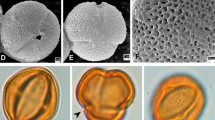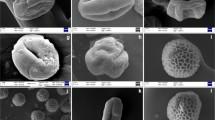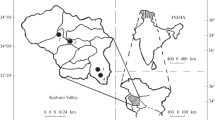Abstract
Pollen morphology of Pyrus L. spp. genus from West Azerbaijan Province of Iran using light microscope and scanning electron microscope was studied. The species under study included Pyrus syriaca, Pyrus amygdaliformis, Pyrus salicifolia, and Pyrus communis. The measured characteristics were longitudinal axis, transverse axis, length-to-width ratio, depth of groove or pore, shapes, and decorations of wall, and size and type of pollen grain (number of tracks). The images and details of the internal structure of all these four pollen species are provided comprehensively. The results showed that the depth of groove or pore was in the range of 1.0–3.12. The pollen species were small or medium-sized and the most common type among them was type III. The pollen grains of these species were symmetrical with three tracks and their wall decorations were striate and striate and micro-reticulate.





Similar content being viewed by others
References
Abdollahi H (2009) Pear tree, planting to harvest. Extension Service of Agricultural Organization of Tehran Province, Tehran, p 10 (in Persian)
Davoodi A (1998) Evaluation of resistance of some apple and pear cultivars to fire blight. MSc. Thesis, College of Agriculture, Tabriz University, Tabriz, p 200 (in Persian)
Elshihy OM, Sharaf AN, Muzher BM (2004) Morphological, anatomical and biochemical characterization of Syrian pear (Pyrus syriaca Boiss) genotypes. Arab J Biotechnol 7(2):209–218
Eti S (1996) Investigation on the fertilization biology of some foreign pear cultivars. Bache 25(1–2):11–19
FAO (2014) FAOSTAT, FAO Statistical Databases (Food and Agriculture Organization of the United Nations). http://www.fao.org/ag/agl/agll/spush/. Accessed 25 Jan 2014
Ishimizu T, Inoue K, Shimonaka M, Saito T, Terai O, Norioka S (1999) PCR-based method for identifying the S-genotypes of Japanese pear cultivars. Theor Appl Genet 91:691–698
Javady T, Arzani K (2001) Pollen morphology of five Iranian olive (Olea europaea L.) cultivars. J Agric Sci Technol 3:37–42
Karadeniz T, Sen SM (1990) Morphological and pomological properties of pears grown in Tirebolu and vicinity. J Fac Agric (Hokkaido University) 1:152–165
Katayama H, Uematsu CH (2006) Pear (Pyrus species) genetic resources in Iwate, Japan. Genet Resour Crop Evol 53:483–498
Khatamsaz M (1992) Rosacea family, flora of Iran, 1st edn. Iranian Research Organization of Forests and Pastures, Tehran (in Farsi)
Khoshghalb H (2001) Study on early growth, performance and survival of Asian pear cultivars (Pyrus serotina Rehd) on European Pear (Pyrus communis L.) seedling rootstock under environmental condition. MSc. Thesis, Tarbiat Modares University, Tehran (in Farsi)
Lanza B, Marsilio V, Martinelli N (1996) Olive pollen ultrastructurization of exine pattern through image analysis-scanning electron microscopy (IA-SEM). Sci Hortic 65:283–294
Li X, Yang J, Li XG, Yang J (2002) Application of numerical taxonomy of pollen morphology on origination, evolution and classification of Pyrus L. in China. J Fruit Sci 19(3):145–148
Li P, Wang Y, Sun X, Han J (2009) Using microsatellite and morphological markers to asses the genetic diversity 12 falcata (Medicago sativa spp. falcate) population from Eurasia. Afr J Biotehnol 8(10):2102–2108
Mohseni S, Rad AS (2017) Determination of compositions of Thymus pubescens; the comparison of different solvents towards extraction. Iran J Sci Technol A. https://doi.org/10.1007/s40995-017-0159-3
Poralijan V, Rad AS (2016) Extraction of eugenol from carnation: a quantitative and qualitative analysis by aqueous and ethanolic solvents. J Essent Oil Bear Plants 19(2016):1495–1502
Wünsch A, Hormaza JI (2007) Characterization of variability and genetic similarity of European pear using microsatellite loci developed in apple. Sci Hortic 113:37–43
Zamani A, Attar F (2010) Pyrus longipedicellata sp. nov. (Rosaceae) from Central Alborz, Iran. Nord J Bot 28:484–486
Zhang Y, Li R, Zhang YY, Li RT (1999) Studies on the local pear resources of Hunan Province: I. SEM observation of pollen morphology of Baojin local pear. Acta Scientiarum Naturalium Universitatis Normalis Hunanensis 22:91–94
Zhou L, Wei Z, Wu Z (2000) Pollen morphology of Maloideae (Rosaceae) in China. Acta Botanica Yunnanica 22:47–52
Author information
Authors and Affiliations
Corresponding authors
Rights and permissions
About this article
Cite this article
Karimi, H., Eslami, B., Dehpouri, A.A. et al. Quantitative and Qualitative Analyses of Genus Pyrus L. (Pear Tree) in West Azerbaijan Province, Iran. Iran J Sci Technol Trans Sci 43, 715–724 (2019). https://doi.org/10.1007/s40995-017-0460-1
Received:
Accepted:
Published:
Issue Date:
DOI: https://doi.org/10.1007/s40995-017-0460-1




